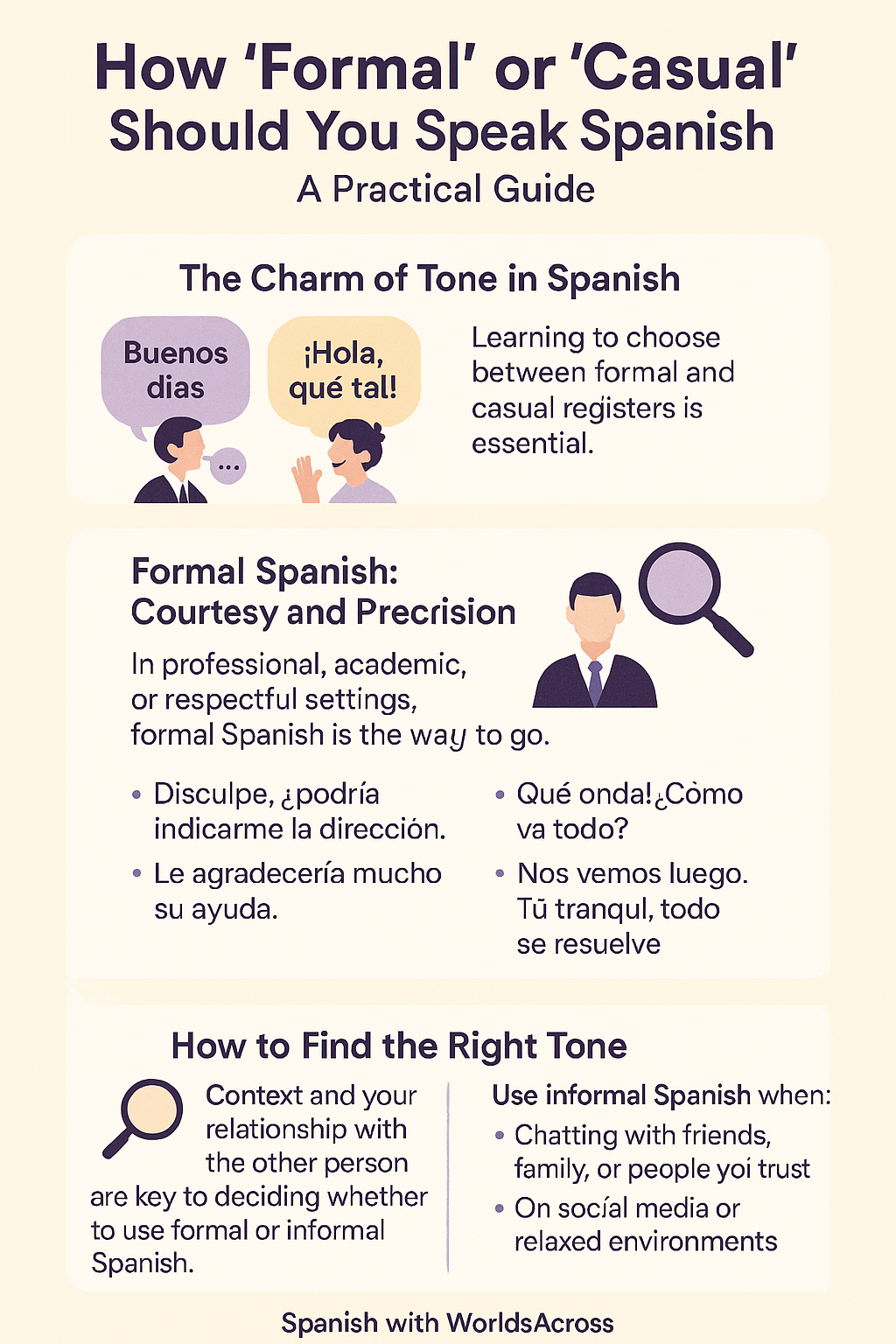How [Formal] or [Casual] Should You Speak Spanish? [A Practical Guide]
In Spanish, choosing between a formal or informal tone changes how a conversation is perceived. Saying “¿Cómo está usted?” is not the same as “¿Qué tal, amigo?” Each phrase has a different impact and sets the tone for the connection you’ll create with the other person.
Speaking correctly isn’t just about grammar or vocabulary—it’s also about understanding the context and adjusting your tone accordingly. In this article, you’ll learn how to speak Spanish correctly and when to use a formal or informal tone to sound natural in any situation.
The Charm of Tone in Spanish
Tone transforms communication. That’s why learning to choose between formal and casual registers is essential. Every situation calls for a different style, and your voice is your calling card. For example, greeting someone with “Buenos días” (Good morning) shows respect in professional settings. On the other hand, using casual expressions like “¡Hola, qué tal!” (Hey, how are you?) builds connection in informal gatherings.
The choice depends on the context and who you’re talking to. Adapting your message creates empathy. Remember: learning how to speak Spanish correctly takes time—but we’re here to help you every step of the way.
Choosing between formal or informal Spanish is crucial for effective communication. In academic or business settings, a formal tone reflects professionalism. In contrast, casual language is ideal for chatting with friends. That’s why becoming familiar with both styles will help you use them strategically.

Formal Spanish: Courtesy and Precision

In professional, academic, or respectful settings—such as speaking to elders—formal Spanish is the way to go. It’s characterized by using “usted,” complete phrases, and polite expressions.
Examples of formal Spanish:
- “Disculpe, ¿podría indicarme la dirección?” / Excuse me, could you tell me the address?
- “Le agradecería mucho su ayuda.” / I would greatly appreciate your help.
- “Fue un placer conversar con usted.” / It was a pleasure talking to you.
This tone conveys respect and professionalism. In emails, meetings, or presentations, formal Spanish helps make a great impression.
Informal Spanish: Closeness and Natural Flow

With friends, family, or in relaxed situations, informal Spanish allows you to express yourself more freely. You’ll find shorter phrases, slang, and in many countries, the pronoun “tú” instead of “usted.”
Examples of informal Spanish:
- “¡Qué onda! ¿Cómo va todo?” / Hey! How’s everything going?
- “Nos vemos luego.” / See you later.
- “Tú tranqui, todo se resuelve.” / Don’t worry, everything works out.
Informal Spanish makes conversations feel more natural and spontaneous. However, using it in the wrong context might come off as disrespectful.
How to Find the Right Tone
Context and your relationship with the other person are key to deciding whether to use formal or informal Spanish. Here are a few helpful guidelines:
Use formal Spanish when:
- Speaking to bosses, clients, or strangers in professional settings
- Talking to older individuals or in respectful situations
- Writing formal emails or attending interviews
Use informal Spanish when:
- Chatting with friends, family, or people you trust
- On social media or in relaxed environments
- Trying to sound more relatable and casual
A useful trick is to mirror the other person’s tone. If they use formality, match it. If they’re casual, using informal Spanish will make the conversation flow better. Mastering this brings you closer to knowing how to speak Spanish correctly.
Speak Spanish Confidently in Any Situation
Mastering the balance between formal and informal Spanish is key to speaking with confidence. Learning to adjust your tone based on context helps you connect better with native speakers and sound authentic.
Listening to Spanish conversations, observing how tone changes in different situations, and practicing with native speakers—like our tutors—are great ways to improve. Spanish is a versatile, dynamic, and rich language. Every word is an opportunity to express yourself with clarity and ease.
Formal or Informal?
Success in communication comes from choosing the right tone. Every interaction gives you a chance to practice and grow. Remember: learning how to speak Spanish correctly is a journey built one day at a time. Practice, listen to native speakers, and adjust your Spanish to every situation. With consistent effort, you’ll master both formal and informal Spanish—and every nuance in between.
Learning a language is a journey filled with discoveries and emotion. Don’t let challenges stop you—keep exploring new ways to express yourself. Your commitment to Spanish will open doors and connect you with amazing cultures.
And don’t forget—we’re here to support you and show you how to speak Spanish correctly.
Let Spanish surround you with its charm and diversity.


